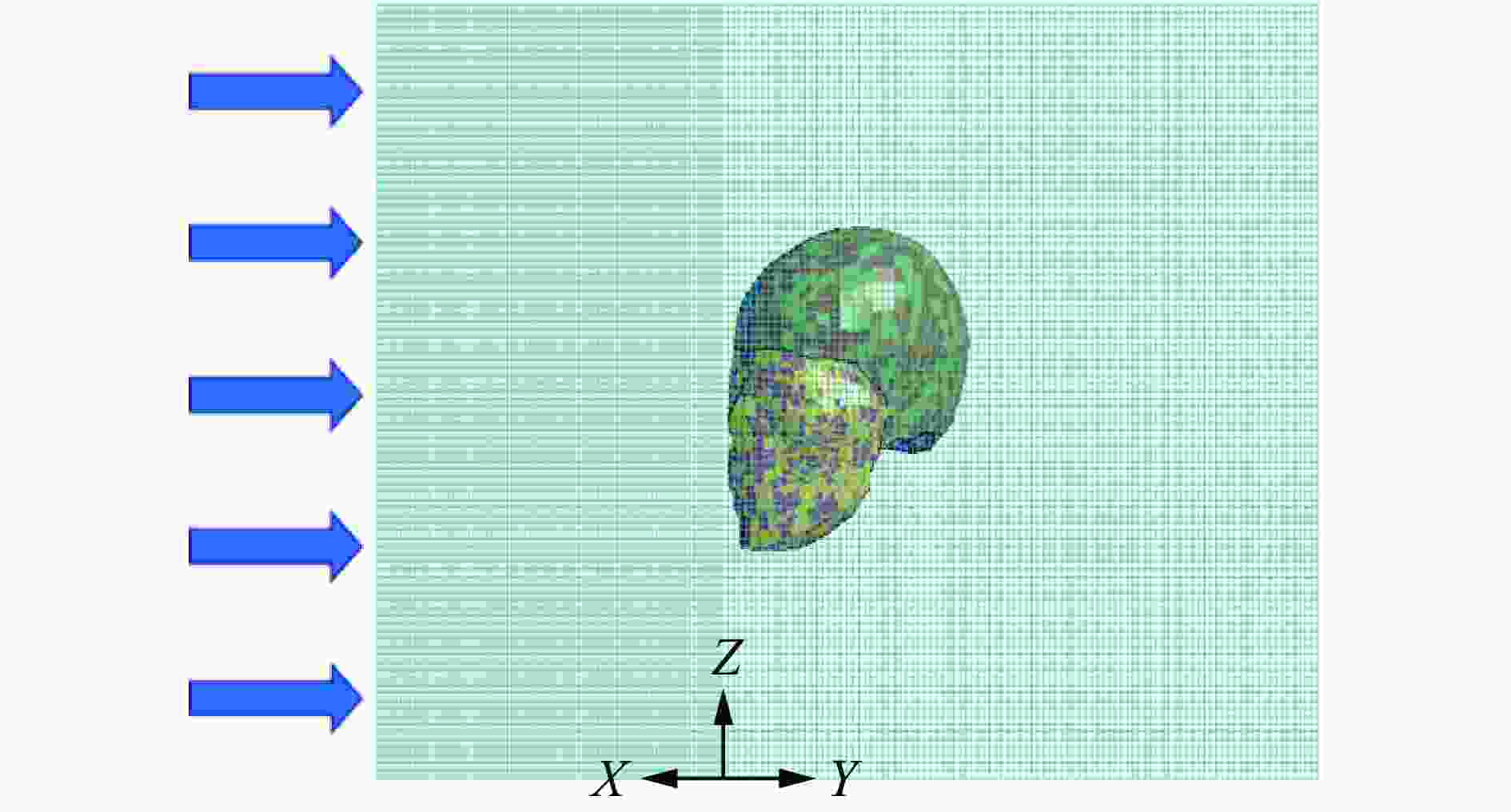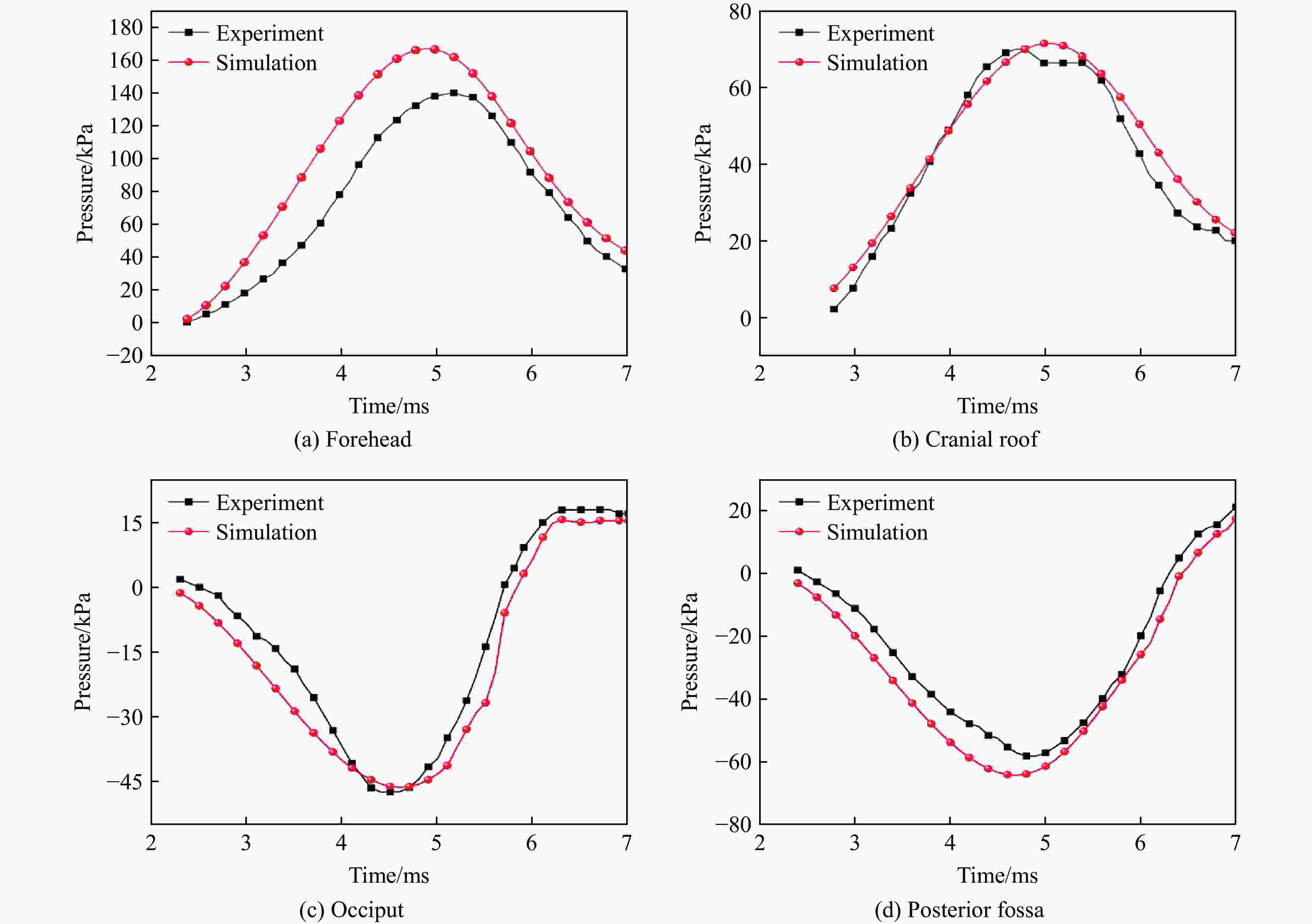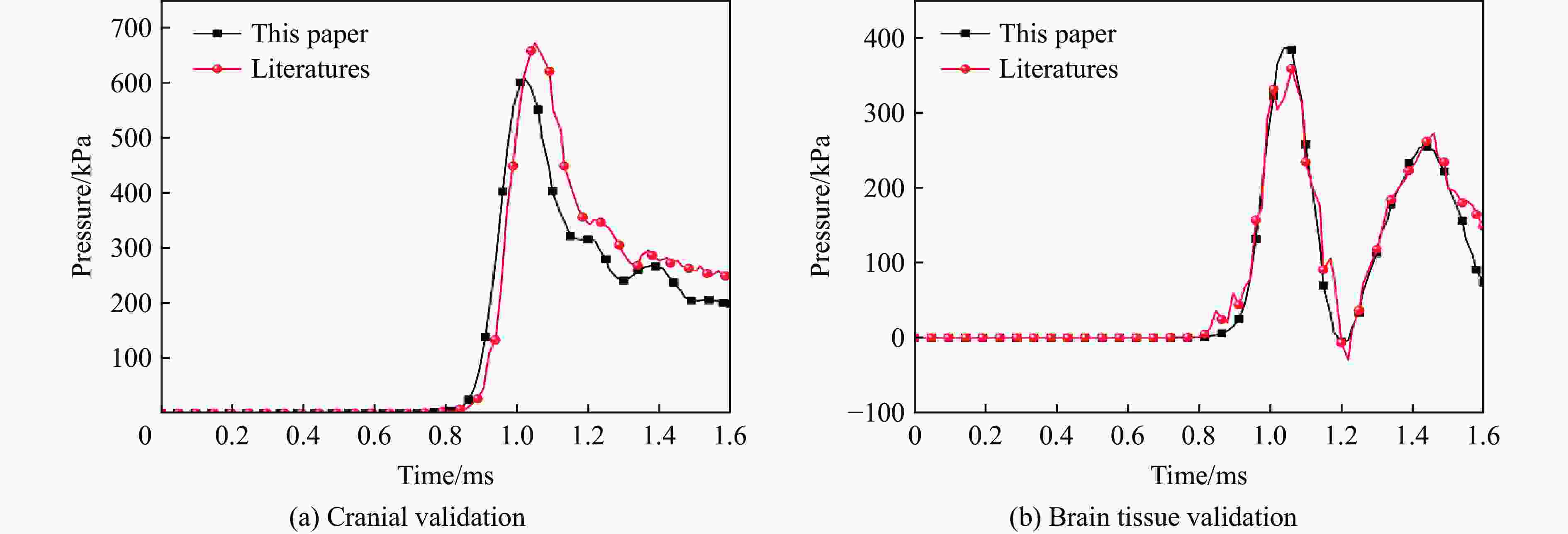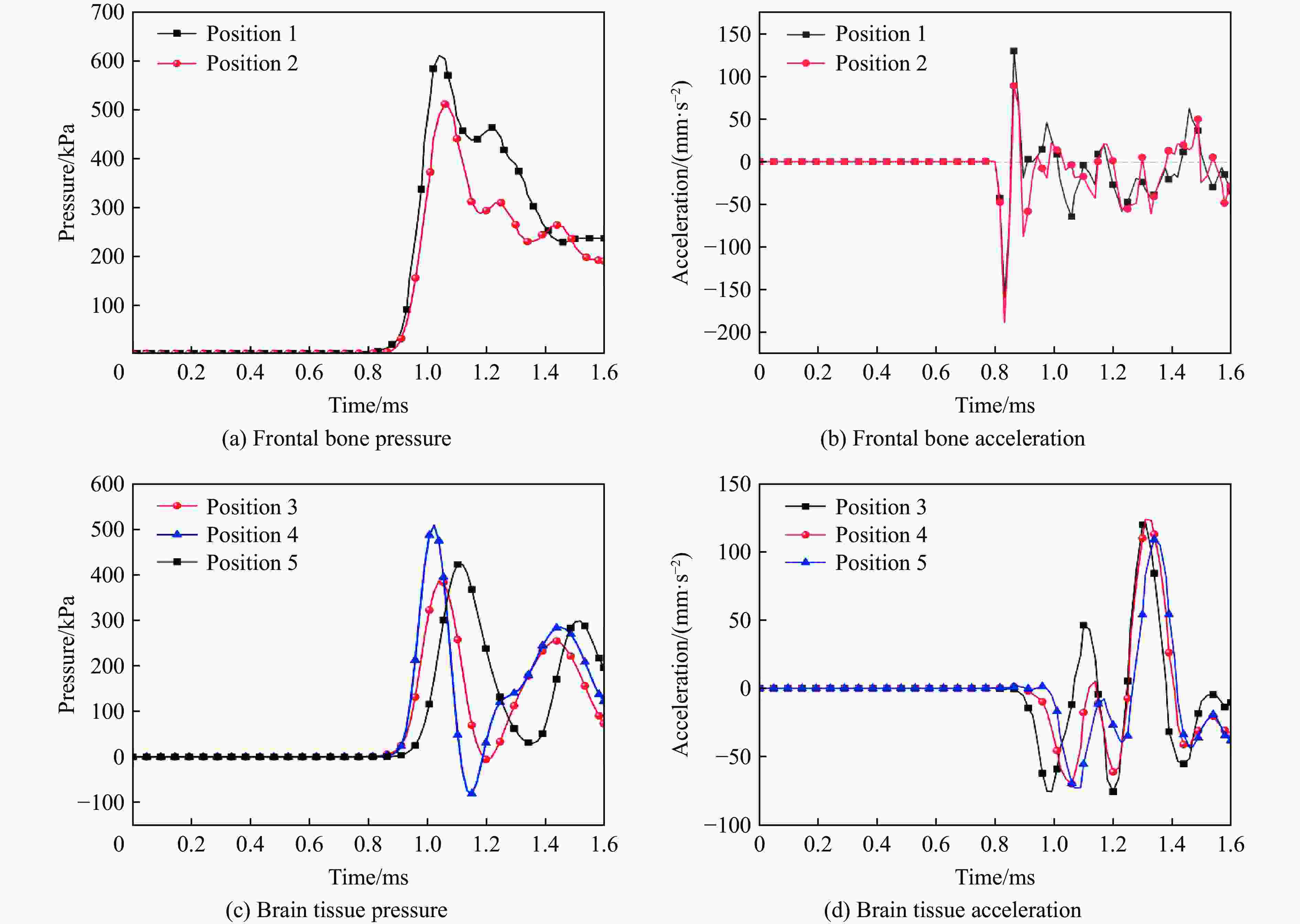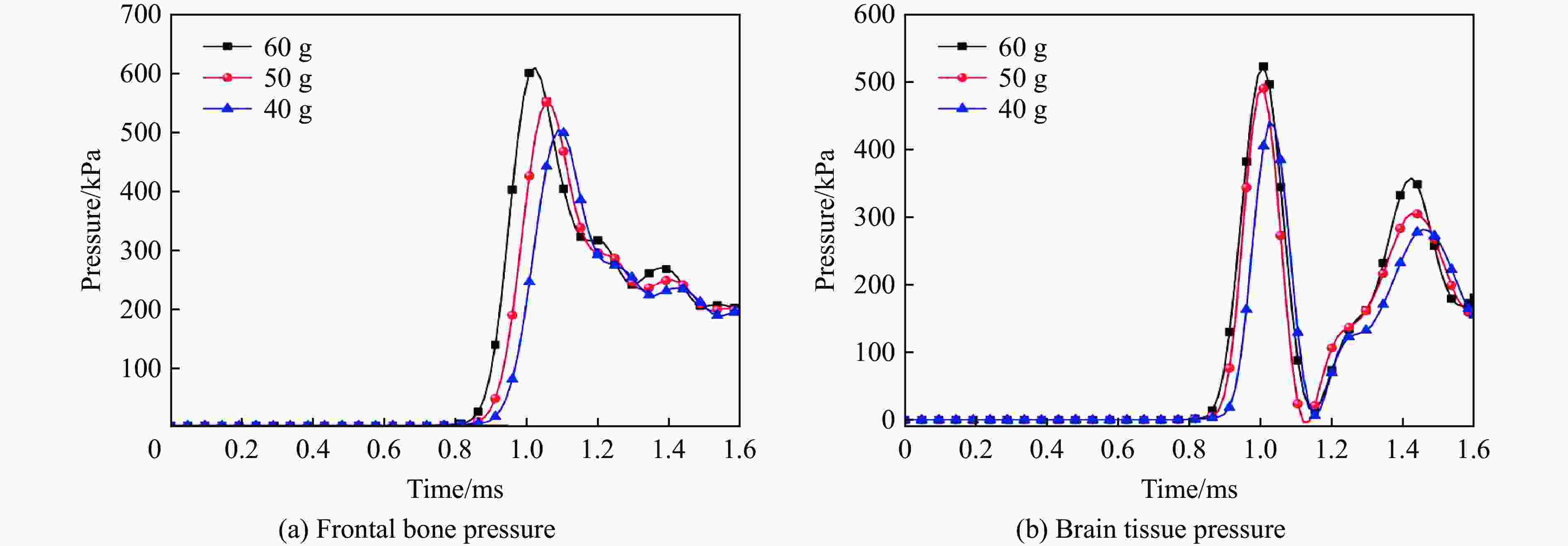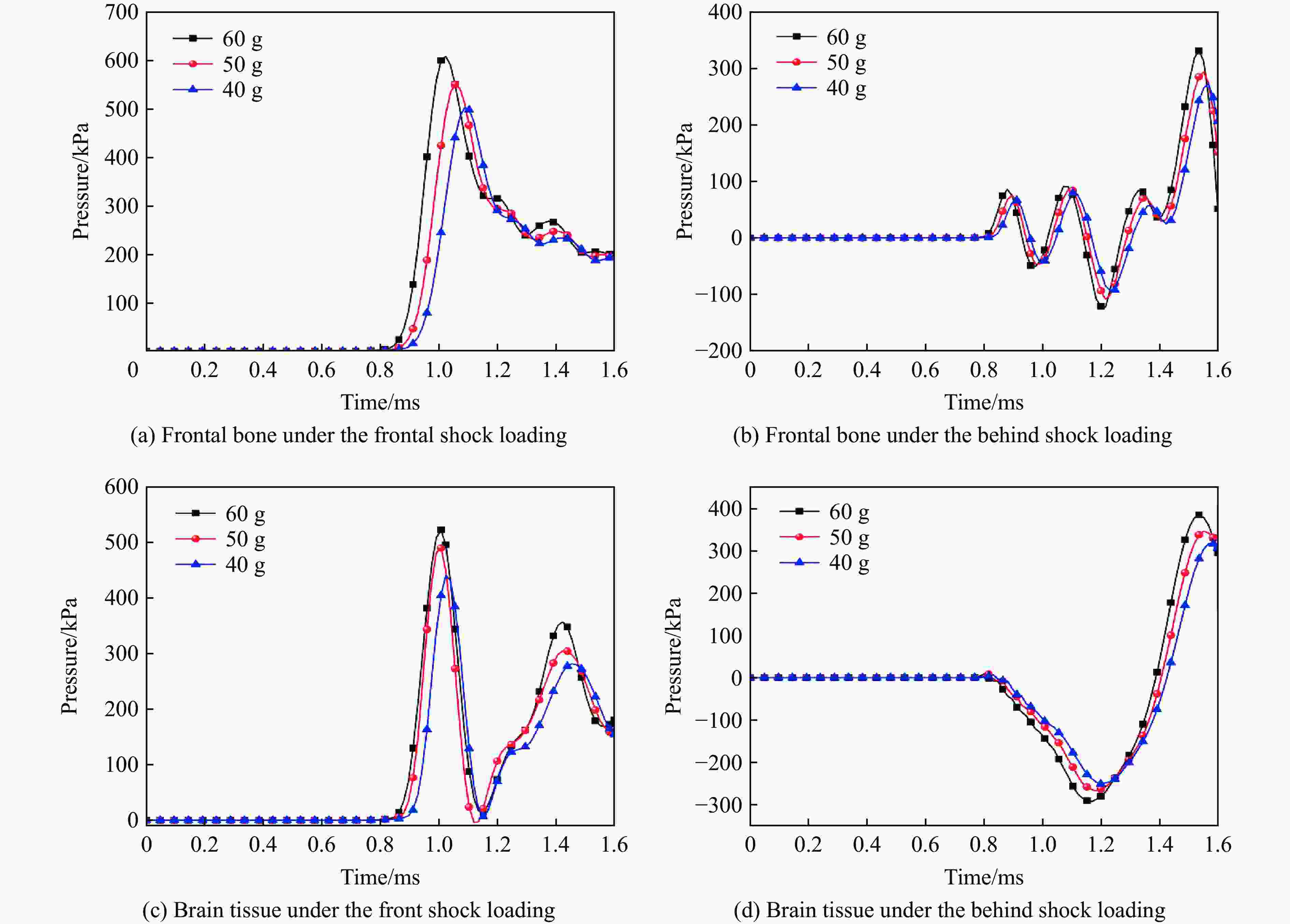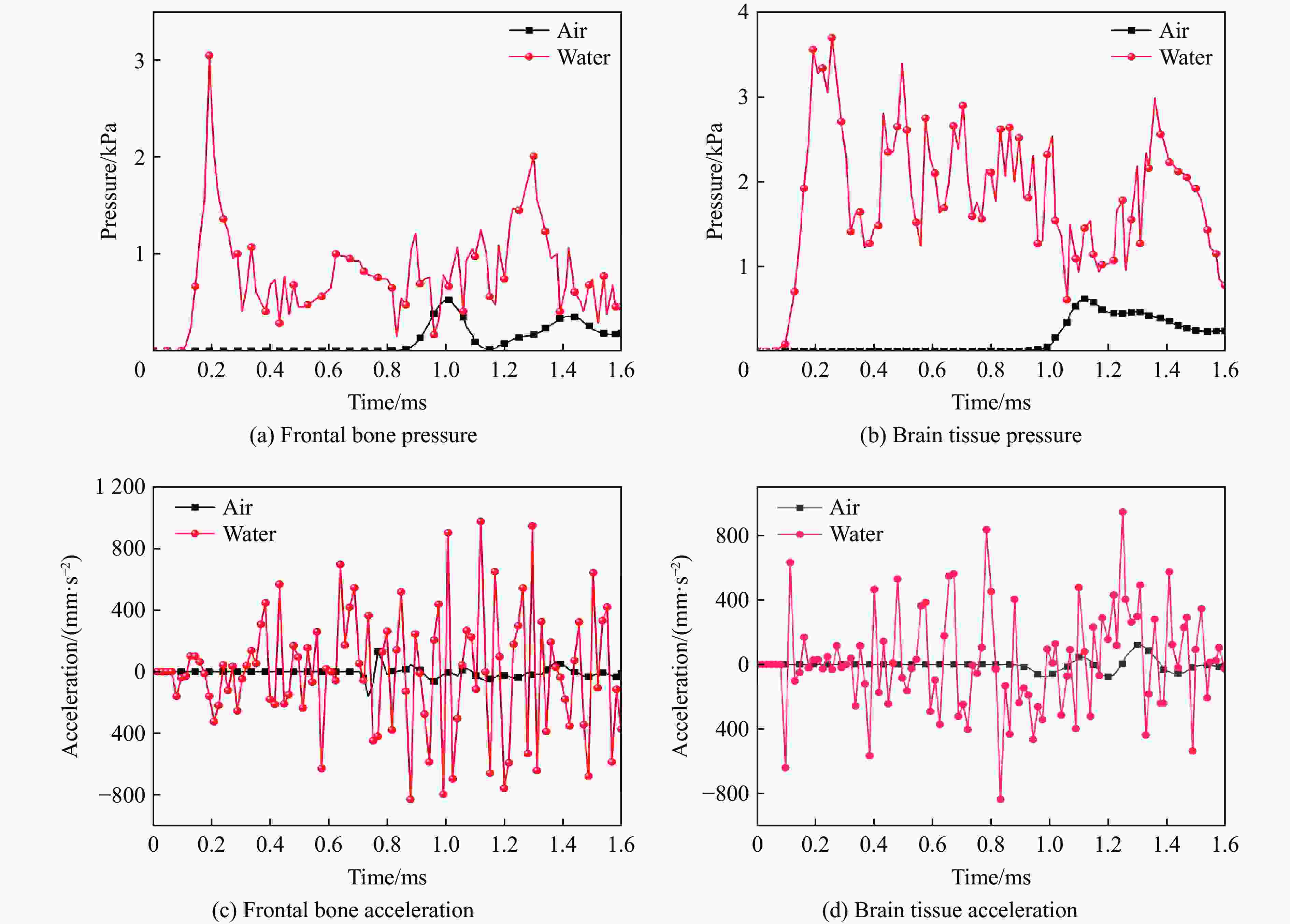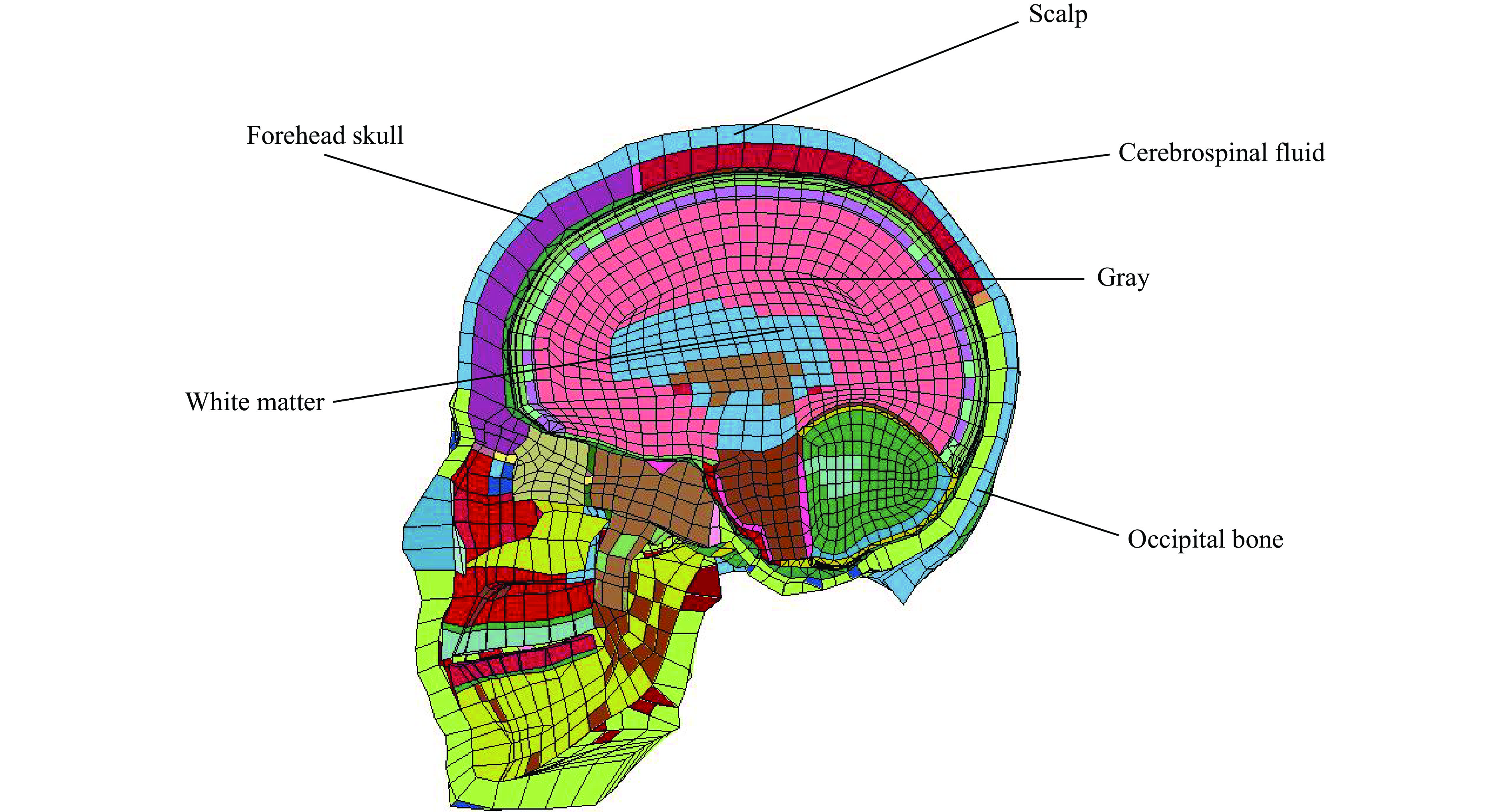Numerical simulation on traumatic brain injury by blast waves
-
摘要: 在军事行动、工业事故等爆炸事件中,爆炸冲击波引起的头部损伤已成为主要致伤形式之一,而爆炸载荷下头部的损伤机理及损伤阈值仍不明确,鉴于此,采用数值模拟研究了爆炸载荷下头部的动态响应过程,分析了TNT药量以及空气和水2种介质对颅脑的变形、压力和加速度的影响。首先,基于欧拉-拉格朗日耦合的方法建立了空气-头部流固耦合模型。在验证其有效性的基础上,从前额颅骨与脑组织的压力、加速度和频率等方面对头部动态响应过程进行了分析。研究发现,爆炸冲击波正面作用于头部时,前额颅骨的超压峰值达到613 kPa,脑组织的超压峰值达到508 kPa,并且颅骨会发生高频振动,振动频率可达7 kHz。前额颅骨和脑组织受到的冲击加速度呈现先升高后降低的变化趋势,同时颅内压呈周期性变化。在水下环境中,额叶、顶叶和颞叶脑组织压力出现高频的周期性超压波动,前额颅骨产生的超压峰值达到3.64 MPa,远高于重度脑损伤的阈值235 kPa。在水中,脑组织受到的压力峰值是空气中的5倍,加速度比空气中约提高了5倍,频率则提高了2倍。Abstract: In military operations, industrial accidents and other explosive events, head injuries caused by blast shock waves have become one of the main injury forms of injury, but the injury mechanism and damage threshold have not been clarified yet. In this paper, numerical simulation is used to study the dynamic response process of the head under explosion load, and the effects of TNT charge, air and water media on the deformation, pressure and acceleration of the cranium and brain are analyzed. First, the air-head fluid-structure interaction model is established using Euler-Lagrangian coupling method. Based on the validation of its effectiveness, the dynamic response process of the head was analyzed in terms of pressure, acceleration and frequency of the prefrontal cranium and brain tissue. By setting the initial conditions and boundary conditions, the effects of frontal and the behind shock loadings of the blast wave on the head were simulated. It has been found that the head tissue vibrates at high frequencies, up to 7 kHz, when the blast wave strikes the head directly. The acceleration on the prefrontal cranium and brain tissue had a large value initially and become small in the late stage, while the intracranial pressure varied in a cyclical manner. In the underwater environment, there were high-frequency periodic overpressure fluctuations in the brain tissues of frontal, parietal and temporal lobes, in which peak overpressure of 3.64 MPa can be generated in the prefrontal cranium, which is well above the threshold of 235 kPa for severe brain injury. In water, brain tissue is subjected to 5 times the peak pressure, a 5 fold increase in acceleration and a 2 fold increase in frequency compared to those in air. The results of this research provide a new perspective for understanding the mechanism of damage to the human brain caused by blast shock waves, and an reference for the development of future protective measures.
-
Key words:
- blast shock waves /
- head finite element model /
- brain injury /
- underwater explosion
-
器官/组织 密度/(kg·m−3) 弹性模量/MPa 泊松比 头皮 1200 16.7 0.42 颅骨 1710 5370 0.19 大脑镰 1130 31.5 0.45 硬脑膜 1130 31.5 0.45 小脑幕 1130 31.5 0.45 蛛网膜 1130 22.0 0.45 软脑膜 1130 11.5 0.45 器官/
组织密度/
(kg·m−3)体积模量/
GPa短效剪切
模量/kPa长效剪切
模量/kPa灰质 1060 2.19 10.0 2.0 白质 1060 2.19 12.5 2.5 脑干 1060 2.19 22.5 4.5 小脑 1060 2.19 12.5 2.0 结构 密度/(kg·m−3) 体积模量/MPa 截断压力/Pa 脑脊液 999.8 1960 −10.0 表 4 不同TNT当量下的脑组织损伤状况
Table 4. Brain tissue damage at different TNT equivalents
TNT当量/g 脑组织损伤因子 是否发生挫裂伤 40 2.55 是 50 2.85 是 60 3.34 是 -
[1] TANIELIAN T, JAYCOX L H, ADAMSON D M, et al. The invisible wounds of war: recommendations for addressing psychological and cognitive injuries [J]. Psychiatric Services, 2009, 60(2): 273–273. DOI: 10.1176/ps.2009.60.2.273. [2] 李创忠, 王运杰. 爆炸冲击波性脑损伤的研究进展 [J]. 临床军医杂志, 2010, 38(2): 311–315. DOI: 10.3969/j.issn.1671-3826.2010.02.061.LI C Z, WANG Y J. Progress in the study of blast shockwave brain injury [J]. Clinical Journal of Medical Officers, 2010, 38(2): 311–315. DOI: 10.3969/j.issn.1671-3826.2010.02.061. [3] WANG Z L, LIU Y P, LEI D L, et al. A new model of blast injury from a spherical explosive and its special wound in the maxillofacial region [J]. Military Medicine, 2003, 168(4): 330–332. DOI: 10.1093/milmed/168.4.330. [4] FENG K, ZHANG L Y, JIN X, et al. Biomechanical responses of the brain in swine subject to free-field blasts [J]. Frontiers in Neurology, 2016, 7: 179. DOI: 10.3389/fneur.2016.00179. [5] RAFAELS K A, DALE’BASS C R, PANZER M B, et al. Brain injury risk from primary blast [J]. Journal of Trauma and Acute Care Surgery, 2012, 73(4): 895–901. DOI: 10.1097/TA.0b013e31825a760e. [6] RAFAELS K, BASS C R, SALZAR R S, et al. Survival risk assessment for primary blast exposures to the head [J]. Journal of Neurotrauma, 2011, 28(11): 2319–2328. DOI: 10.1089/neu.2009.1207. [7] AWAD N, EL-DAKHAKHNI W W, GILANI A A. A physical head and neck surrogate model to investigate blast-induced mild traumatic brain injury [J]. Arabian Journal for Science and Engineering, 2015, 40(3): 945–958. DOI: 10.1007/s13369-015-1583-3. [8] MOSS W C, KING M J, BLACKMAN E G. Skull flexure from blast waves: a mechanism for brain injury with implications for helmet design [J]. Physical Review Letters, 2009, 103(10): 108702. DOI: 10.1103/PhysRevLett.103.108702. [9] CAI Z H, XIA Y, BAO Z, et al. Creating a human head finite element model using a multi-block approach for predicting skull response and brain pressure [J]. Computer Methods in Biomechanics and Biomedical Engineering, 2019, 22(2): 169–179. DOI: 10.1080/10255842.2018.1541983. [10] YU Z H, JING L. Head injury mechanisms of the occupant under high-speed train rear-end collision [J]. Theoretical and Applied Mechanics Letters, 2024, 14(5): 100537. DOI: 10.1016/j.taml.2024.100537. [11] 于振浩, 敬霖, 黄志辉. 高速列车追尾碰撞时乘员头颈部损伤力学响应与风险评估 [J]. 应用力学学报, 2024, 41(1): 77–89. DOI: 10.11776/j.issn.1000-4939.2024.01.008.YU Z H, JING L, HUANG Z H. Mechanical response and risk assessment of head and neck injury in high-speed train rear-end collision [J]. Chinese Journal of Applied Mechanics, 2024, 41(1): 77–89. DOI: 10.11776/j.issn.1000-4939.2024.01.008. [12] 栗志杰, 由小川, 柳占立, 等. 爆炸冲击波作用下颅脑损伤机理的数值模拟研究 [J]. 爆炸与冲击, 2020, 40(1): 015901. DOI: 10.11883/bzycj-2018-0348.LI Z J, YOU X C, LIU Z L, et al. Numerical simulation of the mechanism of traumatic brain injury induced by blast shock waves [J]. Explosion and Shock Waves, 2020, 40(1): 015901. DOI: 10.11883/bzycj-2018-0348. [13] WARD C, CHAN M, NAHUM A. Intracranial pressure: a brain injury criterion [C]// 24th Stapp Car Crash Conference (1980), 1980. DOI: 10.4271/801304. [14] SUTAR S, GANPULE S. Evaluation of blast simulation methods for modeling blast wave interaction with human head [J]. Journal of Biomechanical Engineering, 2022, 144(5): 051009. DOI: 10.1115/1.4053059. [15] 张社荣, 孔源, 王高辉. 水下和空中爆炸冲击波传播特性对比分析 [J]. 振动与冲击, 2014, 33(13): 148–153. DOI: 10.13465/j.cnki.jvs.2014.13.026.ZHANG S R, KONG Y, WANG G H. Comparative analysis on propagation characteristics of shock wave induced by underwater and air explosions [J]. Journal of Vibration and Shock, 2014, 33(13): 148–153. DOI: 10.13465/j.cnki.jvs.2014.13.026. [16] 陈吉钢, 张丹枫, 王春晖, 等. 水下冲击波致比格犬肺和颅脑损伤特点 [J]. 第二军医大学学报, 2019, 40(7): 763–768. DOI: 10.16781/j.0258-879x.2019.07.0763.CHEN J G, ZHANG D F, WANG C H, et al. Underwater shock wave induced lung and brain injuries in canines [J]. Academic Journal of Second Military Medical University, 2019, 40(7): 763–768. DOI: 10.16781/j.0258-879x.2019.07.0763. [17] 李彦腾, 程岗, 魏铂沅, 等. 水下爆炸致水面泅渡战位比格犬脑和肺的损伤特点 [J]. 第二军医大学学报, 2021, 42(7): 755–761. DOI: 10.16781/j.0258-879x.2021.07.0755.LI Y T, CHENG G, WEI B Y, et al. Characteristics of brain and lung injuries of beagles in swimming battle position caused by underwater explosion [J]. Academic Journal of Second Military Medical University, 2021, 42(7): 755–761. DOI: 10.16781/j.0258-879x.2021.07.0755. [18] NAKARMI S, WANG Y H, FAWZI A L, et al. Estimating brain injury risk from shipborne underwater blasts using a high-fidelity finite element head model [J]. Military Medicine, 2025, 190(1/2): 202–210. DOI: 10.1093/milmed/usae309. [19] 张晏铭, 张丹枫, 陈吉钢. 水下爆炸致水面舰艇人员损伤的特点及研究现状 [J]. 第二军医大学学报, 2019, 40(5): 573–576. DOI: 10.16781/j.0258-879x.2019.05.0573.ZHANG Y M, ZHANG D F, CHEN J G. Characteristics and research status of injuries on surface vessels induced by underwater explosion [J]. Academic Journal of Second Military Medical University, 2019, 40(5): 573–576. DOI: 10.16781/j.0258-879x.2019.05.0573. [20] OSHITA F, OMORI K, NAKAHIRA Y, et al. Development of a finite element model of the human body [C]//Proceedings of the 7th International LS-DYNA Users Conference, 2002. [21] SU Z Q, LI D P, LI R, et al. Development and global validation of a 1-week-old piglet head finite element model for impact simulations [J]. Chinese Journal of Traumatology, 2023, 26(3): 147–154. DOI: 10.1016/j.cjtee.2022.07.001. [22] LI Z J, DU Z B, YOU X C, et al. Numerical study on dynamic mechanism of brain volume and shear deformation under blast loading [J]. Acta Mechanica Sinica, 2019, 35(5): 1104–1119. DOI: 10.1007/s10409-019-00875-w. [23] 周清, 张云海, 齐麟. LS-DYNA软件中4种不同爆炸荷载施加方法的比较 [J]. 兵器装备工程学报, 2021, 42(2): 216–221. DOI: 10.11809/bqzbgcxb2021.02.041.ZHOU Q, ZHANG Y H, QI L. Comparison of 4 different methods to impose blast load in LS-DYNA software [J]. Journal of Ordnance Equipment Engineering, 2021, 42(2): 216–221. DOI: 10.11809/bqzbgcxb2021.02.041. [24] 张文超, 王舒, 梁增友, 等. 爆炸冲击波致颅脑冲击伤数值模拟研究 [J]. 北京理工大学学报, 2022, 42(9): 881–890. DOI: 10.15918/j.tbit1001-0645.2021.191.ZHANG W C, WANG S, LIANG Z Y, et al. Numerical simulation on traumatic brain injury induced by blast waves [J]. Transactions of Beijing Institute of Technology, 2022, 42(9): 881–890. DOI: 10.15918/j.tbit1001-0645.2021.191. [25] NAHUM A M, SMITH R, WARD C C. Intracranial pressure dynamics during head impact [C]//Proceedings of the 21st Stapp Car Crash Conference. New Orleans Louisiana, United States, 1977. DOI: 10.4271/770922. [26] WANG C Z, PAHK J B, BALABAN C D, et al. Computational study of human head response to primary blast waves of five levels from three directions [J]. PLoS One, 2014, 9(11): e113264. DOI: 10.1371/journal.pone.0113264. [27] STEMPER B D, SHAH A S, PINTAR F A, et al. Head rotational acceleration characteristics influence behavioral and diffusion tensor imaging outcomes following concussion [J]. Annals of Biomedical Engineering, 2015, 43(5): 1071–1088. DOI: 10.1007/s10439-014-1171-9. [28] 郭泽荣, 李晓禹, 崔潇丹. 球形爆炸冲击波正面作用下人体头部损伤规律的数值模拟 [J]. 安全与环境学报, 2023, 23(7): 2326–2333. DOI: 10.13637/j.issn.1009-6094.2022.0389.GUO Z R, LI X Y, CUI X D. Study on the human head injury caused by blast shock wave [J]. Journal of Safety and Environment, 2023, 23(7): 2326–2333. DOI: 10.13637/j.issn.1009-6094.2022.0389. [29] 蔡志华, 贺葳, 汪剑辉, 等. 爆炸波致颅脑损伤力学机制与防护综述 [J]. 兵工学报, 2022, 43(2): 467–480. DOI: 10.3969/j.issn.1000-1093.2022.02.025.CAI Z H, HE W, WANG J H, et al. Review on mechanical mechanism of blast-induced traumatic brain injury and protection technology [J]. Acta Armamentarii, 2022, 43(2): 467–480. DOI: 10.3969/j.issn.1000-1093.2022.02.025. [30] 栗志杰, 由小川, 柳占立, 等. 基于三维头部数值模型的颅脑碰撞损伤机理研究 [J]. 工程力学, 2019, 36(5): 246–256. DOI: 10.6052/j.issn.1000-4750.2018.04.0254.LI Z J, YOU X C, LIU Z L, et al. Study on the mechanism of brain injury during head impact based on the three-dimensional numerical head model [J]. Engineering Mechanics, 2019, 36(5): 246–256. DOI: 10.6052/j.issn.1000-4750.2018.04.0254. [31] 张洪武, 郑勇刚. “复杂装备研发数字化工具中的计算力学和多场耦合若干前沿问题”立项报告 [J]. 科技创新导报, 2016(19): 176–177. DOI: 10.3969/j.issn.1674-098X.2016.19.097. -






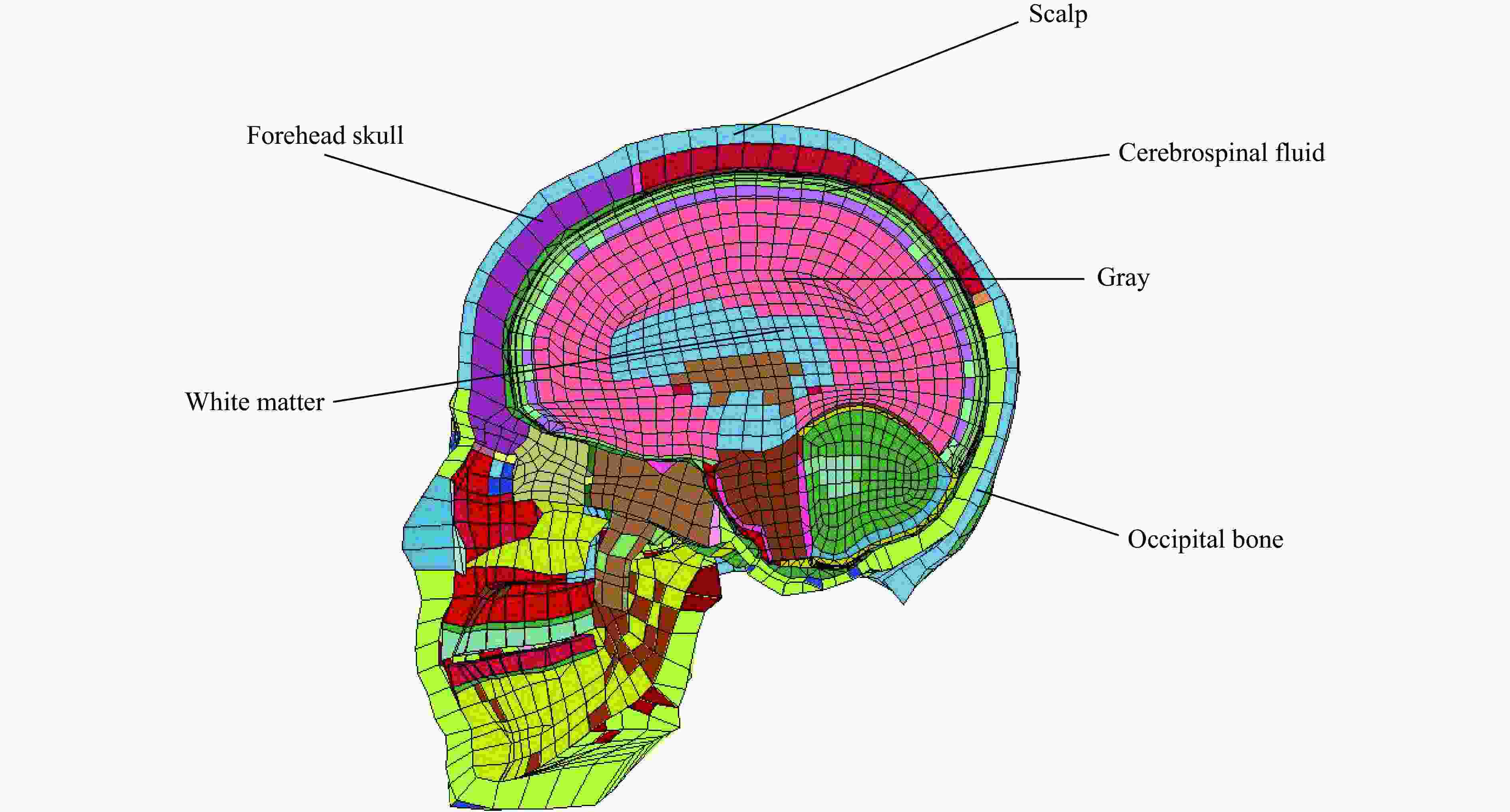
 下载:
下载:
